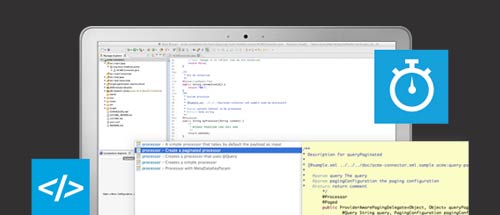Validating data can be easy with Mule if your message payloads are in certain formats. XML payloads, for instance, can be verified for correctness via XML schema or XPath filters. Payload type filters and OGNL expression evaluation can go a long way in asserting your POJO payloads are correct.
Payloads with less structure, like Map or JSON data, are a little bit trickier to validate. This is particularly true on the front-end of web-services where leniency in data format, particularly JSON, can be beneficial. In these cases a custom Message Processor is usually necessary to filter or sanitise the data.
Month: November 2011

Implementing Custom Validation with DevKit
Cloud Platforms and Open APIs: The new application stack

Application stacks are so passé, now its all about the slice. With the rise of open APIs we are seeing a new breed of application. Infrastructure APIs are cropping up everywhere for doing things like email, FTP, monitoring and management, analytics and application security. These slices of functionality, delivered as services, remove the time consuming need to set up services locally and allow developers to spend their time building their application. Adoption of these infrastructure APIs means application architecture doesn’t look the same as it did. Piece by piece the sub systems for an application such as data, security, user management, notifications, integration and messaging are being hosted outside the application. Furthermore, there is a wealth of new services available to applications providing new capabilities such as telephony, facial recognition, address validation, geocoding/geolocation, social media mining, carbon footprint calculators – pretty much anything you need and more to build your killer app. This means application development is becoming a lot more about composition of of open APIs, not coding it all yourself.
Continue readingGet real-time with the new SalesForce API

Before streaming APIs, if you wanted to know if there were any updates on a specific event you had to query the API periodically and check if updates indeed occurred. Most likely, many of these queries would probably return no results as no new event happened but still resources were consumed in the process including the API call and parsing the response. Now, what if you want to get notified not only of 1 event but 10, 20 or 100? Wasting resources like this is not acceptable both for a the application consuming the API and for the API provider and that is why streaming emerged.
Continue readingConnector of the Week: Using the LinkedIn API
Of all the professional networks available LinkedIn has clearly taken the lead with more than 120 million members. Do you use LinkedIn? Most likely you do! That’s why we thought it’s important to have a Cloud Connector to interact with LinkedIn and take advantage of its social power.
Continue readingMule Tip: Including formatted SQL statements from external files in your application
When developing a Mule Application the normal way to define an SQL statement is by declaring it directly in the connector, as shown in the following snippet.
However is possible that you’ll face a situation in which you have to use large and complex queries. For that scenario the previous approach is not adequate since you’ll end up with a configuration difficult to read. So the best thing to do is to externalize these queries in one or more files.
Continue readingSecurity in the Cloud: Protecting Your Applications
Security around public cloud offerings has always been a major point of concern (and controversy) for users. How do cloud providers protect customer data? How is log data protected? How is the surrounding infrastructure secured? We previous talked about how iON stays up and running even through EC2 outages. Today, we will talk about iON security to show how we protect customer information and the infrastructure used in building iON.
Continue readingMule Studio Beta Milestone 5 Released!
We are pleased to announce the Beta Milestone 5 release of Mule Studio, the graphical design tool for Mule ESB. At its core, it is based on the Eclipse Development Platform which many developers are already familiar with. But we have added significant functionality to it to achieve a very tight integration to Mule ESB. This makes Mule Studio a powerful visual and coding environment for developing Mule ESB applications.
Continue readingGive your application a voice of its own with Twilio

The last time we talked I show you how you can easily build RESTful APIs on top of iON. I just covered just a very narrow scenario, the sky is the limit when talking about the kind of integrations that you can build using iON. So this week I’m going to walk you through another interesting use case, IVRs. If you don’t know what they are, don’t worry I will cover the basics in this article. Stick around it’s going to be wild.
AMQP and the future of web messaging
Last month the AMQP working group, which includes big hitters such as Bank of America, Credit Suisse, JPMorgan Chase, Barclays, Goldman Sachs, Microsoft, Cisco, VMWare, Redhat, and Informatica finalised version 1.0 of the AMQP standard. It has been 5 years in the making, the market for messaging has changed a lot in that time.
What is AMQP?
“The Advanced Message Queuing Protocol (AMQP) is an open standard application layer protocol for message-oriented middleware. The defining features of AMQP are message orientation, queuing, routing (including point-to-point and publish-and-subscribe), reliability and security.” – Wikipedia
The specifications are available on-line and several broker implementations exist, like the popular RabbitMQ and Apache Qpid. AMQP is built around a few easy to grasp concepts:
Continue readingIntegration Matters at PeopleMatter
We have been seeing incredible early success with our iON integration platform as a service (iPaaS). We have talked with over a hundred SaaS providers over the past couple of months, and overwhelmingly, we are hearing that integration is a major challenge for them as they go to market. Time and time again, these SaaS providers have been telling us that their customers increasingly need to integrate their SaaS offering with other SaaS and on-premise systems. Point-to-point custom integration and other existing tools are no longer cutting it. In fact, integration is becoming the #1 barrier to closing new sales, even above things like security, price, and features of the solution. Once the deal closes, integration is by far the most time-consuming and complex element of implementing and on-boarding new customers.
Continue reading



